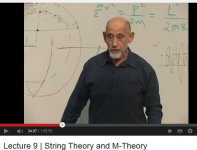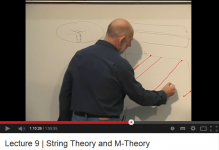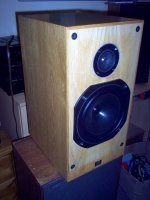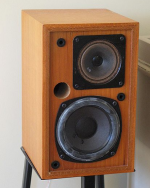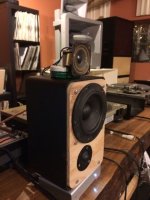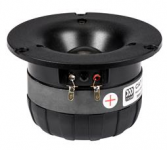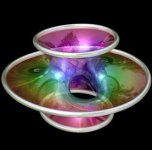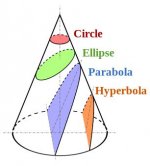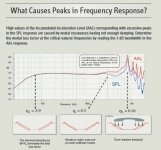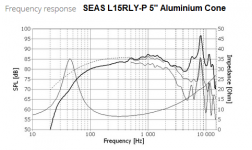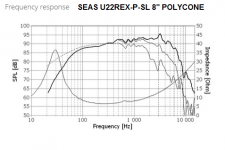measuments
Charlie,
Yes, you a correct, I am mostly experimenting and doing by "ear". However, I am also doing some measurements, namely: pink noise near field and mid field freq response measurements with calibrated mic; on/off axis. That's about it.
I agree with what you say. But I must add. All tweeters that I had tested have their own type of sound (character) even with DSP EQ and notch filters for a ruler flat response. EQ makes the sound "phasey" so do steep filters but irregardless of that, the "character" persists. I am sure that "character" can be explained by measurements. I am not looking for that type of explanation even though they are scientifically deduced.
I can say this and it is all that matters to me. No matter what you try the Vifa ne19tvs 3/4" soft dome sound like crap to me. And the "to me" part is important. It does not have energetic sound that pressurizes the room (even slightly). It is like hitting a cyclone fence outdoors. To one degree or another I hear this in all soft dome tweeters that I have.
What I am looking for is more of the sound you get from a good horn compression tweeter but a little less harsh and in a smaller package. Are there dome tweeters that can do that?
Also, the fact that you invoke "tone" seems to suggest that you are the type of experimenter that tries to do everything "by ear". Is that true?
...
Really... a tweeter with a "rich tone"???! WHAT IS THAT?
Charlie,
Yes, you a correct, I am mostly experimenting and doing by "ear". However, I am also doing some measurements, namely: pink noise near field and mid field freq response measurements with calibrated mic; on/off axis. That's about it.
I agree with what you say. But I must add. All tweeters that I had tested have their own type of sound (character) even with DSP EQ and notch filters for a ruler flat response. EQ makes the sound "phasey" so do steep filters but irregardless of that, the "character" persists. I am sure that "character" can be explained by measurements. I am not looking for that type of explanation even though they are scientifically deduced.
I can say this and it is all that matters to me. No matter what you try the Vifa ne19tvs 3/4" soft dome sound like crap to me. And the "to me" part is important. It does not have energetic sound that pressurizes the room (even slightly). It is like hitting a cyclone fence outdoors. To one degree or another I hear this in all soft dome tweeters that I have.
What I am looking for is more of the sound you get from a good horn compression tweeter but a little less harsh and in a smaller package. Are there dome tweeters that can do that?
There are times when I know I should stay out of a thread. This should be one of them.
My first set of speakers used the Accuton 3/4" diamond tweeter, the Accuton 6.5" C173 midrange, and a 15" active woofer. I too found them a bit on the tizzy side. The better the capacitors used, the lower the tizzyness. My customers loved them. I needed to make them better. The 'thing' that I heard, only a few others noticed. Not everyone's hearing is the same.
My next set used the slightly smaller C158 midrange, and this lowered the tizzies a bit more. This speaker also crossed a little higher, 2,800Hz vs 2,500Hz. In my case the higher crossover frequency was likely the cure.
The above speakers where all parallel crossovers.
I am now experimenting with 2nd order series crossovers, all Duelund CAST PIO capacitors, and the tizzyness is gone.
My Accuton diamond tweeters are now silky smooth, buttery, sublime, rich in colour, and any other word you want to use.
My speakers start out as simulations. Crossovers are tested, measured, changed, measured, etc.
The final tweaking is ALWAYS done by ear.
YMMV
My first set of speakers used the Accuton 3/4" diamond tweeter, the Accuton 6.5" C173 midrange, and a 15" active woofer. I too found them a bit on the tizzy side. The better the capacitors used, the lower the tizzyness. My customers loved them. I needed to make them better. The 'thing' that I heard, only a few others noticed. Not everyone's hearing is the same.
My next set used the slightly smaller C158 midrange, and this lowered the tizzies a bit more. This speaker also crossed a little higher, 2,800Hz vs 2,500Hz. In my case the higher crossover frequency was likely the cure.
The above speakers where all parallel crossovers.
I am now experimenting with 2nd order series crossovers, all Duelund CAST PIO capacitors, and the tizzyness is gone.
My Accuton diamond tweeters are now silky smooth, buttery, sublime, rich in colour, and any other word you want to use.
My speakers start out as simulations. Crossovers are tested, measured, changed, measured, etc.
The final tweaking is ALWAYS done by ear.
YMMV
I understand your bravery in getting involved on the "Tone" subject, Cousin Billy! 😀
But "Tone" was a word that we used back in the day of valves and simple crossovers and lively efficient drivers. We usually associated it with musicality. That ability of a system to get you involved with the music. 🙂
You, of course, are using a $2900 Accuton Diamond. I use $6 jobbies like the Monacor HT-22/8.
Here's my thoughts on tweeters:
Soft domes are terrible things IMO. The mush they produce from the centre of the dome is just not music. It's not a question of frequency response, more that they just produce so much white noise when driven by a pure tone. We used to call this "White noise testing" in telecoms.
Mathematically, a torus works better than a dome. So a toroidal Vifa XT25 is a better musical design than a Morel CAT 298. Because it pins the troublesome centre of a sphere. But at the cheap end, I do cone tweeters. 😱
But "Tone" was a word that we used back in the day of valves and simple crossovers and lively efficient drivers. We usually associated it with musicality. That ability of a system to get you involved with the music. 🙂
You, of course, are using a $2900 Accuton Diamond. I use $6 jobbies like the Monacor HT-22/8.
Here's my thoughts on tweeters:
This is the ubiquitous soft dome tweeter, found in most speakers, you could call it the "Standard Model." 🙄
An externally hosted image should be here but it was not working when we last tested it.
Problem with it is that at high frequency, around 7kHz, it goes into complete breakup in the middle of the dome, and spits and sizzles at you. They always sound awful. But you are probably used to the sound.
A much better sounding tweeter is the Vifa XT25 ring radiator (aka Ring Torus). The centre is pinned stationary, and it has a musical delivery:
An externally hosted image should be here but it was not working when we last tested it.
SB Acoustics have something more like a spindle Torus, but the same pinned centre:
An externally hosted image should be here but it was not working when we last tested it.
These tweeters don't break up so catastrophically. They are based on string theory...that's why they are good...😉
Soft domes are terrible things IMO. The mush they produce from the centre of the dome is just not music. It's not a question of frequency response, more that they just produce so much white noise when driven by a pure tone. We used to call this "White noise testing" in telecoms.
Mathematically, a torus works better than a dome. So a toroidal Vifa XT25 is a better musical design than a Morel CAT 298. Because it pins the troublesome centre of a sphere. But at the cheap end, I do cone tweeters. 😱
Attachments
tweeters
System7,
I am glad you are getting my unscientific, subjective but real point. In a lack of ring radiator tweeters I have temporarily (maybe not) settled on a paper cone mcintosh tweeter. After this tweeter my morel cat378 needs to be thrown in the trash. I hear you system7!
ps: notice the burned vifa tweeter at the bottom of the cabinet. I am glad that thing burned. At least got some function out of it.
System7,
I am glad you are getting my unscientific, subjective but real point. In a lack of ring radiator tweeters I have temporarily (maybe not) settled on a paper cone mcintosh tweeter. After this tweeter my morel cat378 needs to be thrown in the trash. I hear you system7!
ps: notice the burned vifa tweeter at the bottom of the cabinet. I am glad that thing burned. At least got some function out of it.
Attachments
Last edited:
Accuton C30 CELL tweeter. Nice sounding 30 mm ceramic dome tweeter- Similar to the diamond tweets but I think livelier sounding. I preferred them to the 30mm Beryllium Focal Utopia III units. They can be crossed over relatively low, and they are VERY revealing of everything, especially the parts quality of the parts in your crossovers.
I'm not really a fan of the whole substitute DSP active crossover game, myself. It adds some rather significant hurdles to achieving real integration. The DSP itself adds so much of its own character to the system that I see little value in it aside from getting baseline measurements to plug into a crossover simulation package. The sound is likely to be crippled from the start by the electronics. In my experience, its better to cobble together a simple passive crossover with spares. YMMV, though…
I'm not really a fan of the whole substitute DSP active crossover game, myself. It adds some rather significant hurdles to achieving real integration. The DSP itself adds so much of its own character to the system that I see little value in it aside from getting baseline measurements to plug into a crossover simulation package. The sound is likely to be crippled from the start by the electronics. In my experience, its better to cobble together a simple passive crossover with spares. YMMV, though…
"on a paper cone mcintosh tweeter"
They weren't bad, but they weren't all that good either (I have four of them laying around).
There was a knock-off made in the far east that sounded better.
They weren't bad, but they weren't all that good either (I have four of them laying around).
There was a knock-off made in the far east that sounded better.
The Peerless MT-225 was the alnico drive predecessor to the 801730, used in McIntosh loudspeaker models ML-1C, Ml-2C, ML-2M, ML-4C, ML-4M and ML-10C.
These were also used in all the collectible SONAB models, including various Electro-Voice, Dynaco, Rectilinear & many others.
The Matsushita EAS-5PH31S (a copy) sounds better.
These were also used in all the collectible SONAB models, including various Electro-Voice, Dynaco, Rectilinear & many others.
The Matsushita EAS-5PH31S (a copy) sounds better.
Anyone willing to get rid of a Morel product in a perfectly working order,
please let me know the dumpster coordinates and time of arrival!🙂
please let me know the dumpster coordinates and time of arrival!🙂
haha Lojzek
noticed the Morel that he shows is the entry level model, they never had that one until one day they raised the core product prices, then they gave the penny pinchers what they asked for. to compare fairly select one with a back chamber at least!
I been out of the game for while, so I reckon some of the SB Acoustics models are a real value leader now.
noticed the Morel that he shows is the entry level model, they never had that one until one day they raised the core product prices, then they gave the penny pinchers what they asked for. to compare fairly select one with a back chamber at least!
I been out of the game for while, so I reckon some of the SB Acoustics models are a real value leader now.
Cat378 is not the entry level product (The one Steve showed may well be). It is actually a really nice driver with a hidden benefit. With the right drivers you can attain mechanical time alignment without doing anything fancy with the baffle 🙂
It is semi horn loaded, which sets the acoustic centre back behind the baffle. This is a nice thing to have.
I was originally going to get MDT-33's but was persuaded to go with the DMS-37's (the cat-378 predecessor) because of the huge benefit of time alignment when used in conjunction with MW-144 midbass drivers where the tweeter is flush mounted and the mid-bass surface mounted.
I'm really fussy about tweeters, and I've been completely happy with these 🙂
Tony.
It is semi horn loaded, which sets the acoustic centre back behind the baffle. This is a nice thing to have.
I was originally going to get MDT-33's but was persuaded to go with the DMS-37's (the cat-378 predecessor) because of the huge benefit of time alignment when used in conjunction with MW-144 midbass drivers where the tweeter is flush mounted and the mid-bass surface mounted.
I'm really fussy about tweeters, and I've been completely happy with these 🙂
Tony.
Attachments
Ever tried the horny Wavecor tweeters?
TW013WA01
TW030WA11_12
And for System 7 there are some low(er) budget Vifa ring radiators:
XT19NC30-4, OT19NC00-04 and XT25SC-90/04. All are around £15
At the other end of the spectrum are these cone tweeter: Davis TW26K & TW26 G.
Yours for around £170 a pop!
TW013WA01
TW030WA11_12
And for System 7 there are some low(er) budget Vifa ring radiators:
XT19NC30-4, OT19NC00-04 and XT25SC-90/04. All are around £15
At the other end of the spectrum are these cone tweeter: Davis TW26K & TW26 G.
Yours for around £170 a pop!
Cat378 is not the entry level product (The one Steve showed may well be)
It is semi horn loaded, which sets the acoustic centre back behind the baffle. This is a nice thing to have.
Tony.
Indeed my comment was about Steve's.
love to try the horn loaded models, single series capacitor to flatten the LF response! I have a pair of the original Dyn D28 horns ( circa 1981) from which the Morels where a direct knock-off.
It can be recognized from many of the Morel transducer designs; they are remarkably similar to the Dynaudio designs.History of Dynaudio
When was the soft dome tweeter invented? Around the early seventies IIRC. The metal domes came in around the eighties. Both were impressive on dispersion.
Both have slight issues. Soft domes can be fizzy, and really not very detailed at HF, aluminium metal domes have a definite metallic harmonic pattern. Both seem to benefit from a Zobel impedance correction or a horn loading.
The newest hardest Beryllium domes might be very good indeed, except that Beryllium is one of the most toxic substances on the planet! We used to be very afraid of handling it in the lab! 🙁
My intuition about cone tweeters comes from the fact that the cone seems to work well in general. That's if we don't try electrostatic panels, which really are remarkable.
Troels Gravesen certainly gives the old JBL LE26 time of day, even with a shallow horn on occasion:
JBL LE26 tweeter-
And McIntosh used them in various ways for years, sometimes with a metal dustcap:
McIntosh Drivers--Tweeters
Not much development going on, but this Monacor SPP-90 polycone tweeter looks interesting.
Like Robin Marshall, I think there is a good cone tweeter waiting to be made.
I don't look at frequency response so much these days. I get more interested in geometry. 😎
Both have slight issues. Soft domes can be fizzy, and really not very detailed at HF, aluminium metal domes have a definite metallic harmonic pattern. Both seem to benefit from a Zobel impedance correction or a horn loading.
The newest hardest Beryllium domes might be very good indeed, except that Beryllium is one of the most toxic substances on the planet! We used to be very afraid of handling it in the lab! 🙁
My intuition about cone tweeters comes from the fact that the cone seems to work well in general. That's if we don't try electrostatic panels, which really are remarkable.
Troels Gravesen certainly gives the old JBL LE26 time of day, even with a shallow horn on occasion:
JBL LE26 tweeter-
And McIntosh used them in various ways for years, sometimes with a metal dustcap:
McIntosh Drivers--Tweeters
Not much development going on, but this Monacor SPP-90 polycone tweeter looks interesting.
Like Robin Marshall, I think there is a good cone tweeter waiting to be made.
I don't look at frequency response so much these days. I get more interested in geometry. 😎
Attachments
Last edited:
The soft dome tweeter is a particular type of tweeter invented and patented in 1967 by Bill Hecht, a renowned pioneer in the early days of audio engineering and the founder of Phase Technology.
Morel never "knocked off" the dynaudio designs, they pay a license fee for certain technologies! 🙂
The Dynaudio polycone woofers, with large voicecoil, have a remarkable natural rolloff for small drivers that makes filtering easy, for instance.
I found Zaph's list of good drivers interesting. Especially measurements of Troels' newish JA8008 well behaved and dynamic 8" paper woofer.
Zaph|Audio - Page2RSS
It's about 900mH, Qt 0.27, Fs 48Hz, Vas 37L as I expected.
But what is a good driver? Often just a sweet compromise of all the interrelated variables. The below is some Klippel Literature and some real world drivers.
Breakup and Surround issues with cones, for instance. IMO, it's mostly in the geometry and the material chosen. I'd like to see some Klippel analysis of tweeters.
The Dynaudio polycone woofers, with large voicecoil, have a remarkable natural rolloff for small drivers that makes filtering easy, for instance.
I found Zaph's list of good drivers interesting. Especially measurements of Troels' newish JA8008 well behaved and dynamic 8" paper woofer.
Zaph|Audio - Page2RSS
It's about 900mH, Qt 0.27, Fs 48Hz, Vas 37L as I expected.
But what is a good driver? Often just a sweet compromise of all the interrelated variables. The below is some Klippel Literature and some real world drivers.
Breakup and Surround issues with cones, for instance. IMO, it's mostly in the geometry and the material chosen. I'd like to see some Klippel analysis of tweeters.
Attachments
Last edited:
Why do so many SEAS cones show that weird ragged response, raised by 3-5dB, from around 400Hz to 1200Hz?
It is more pronounced with their metal cones but still visible with poly and paper ones.
It is more pronounced with their metal cones but still visible with poly and paper ones.
The Dayton RS28A-4 tweeter is highely regarded over a PETT by one of the top speaker design gurus. Give it a try. PE has a very good return policy as long as you don't mess it up and include orig. packaging.
IME, the rise is exaggerated on SEAS's graphs.Why do so many SEAS cones show that weird ragged response, raised by 3-5dB, from around 400Hz to 1200Hz?
It is more pronounced with their metal cones but still visible with poly and paper ones.
I believe SEAS do their anechoic measurements in some fairly typical boxes, rather than infinite baffle or a standard IEE baffle.Why do so many SEAS cones show that weird ragged response, raised by 3-5dB, from around 400Hz to 1200Hz?
It is more pronounced with their metal cones but still visible with poly and paper ones.
IIRC, they use about 11L closed for 5" drivers, 25L closed for 8" drivers, etc. So what you might be seeing is a baffle effect.
That might be realistic, as it goes. Troels always seems to look out for irregularities around 500Hz in his designs, hence his frequent use of an LCR notch. 🙂
That Dayton Audio RS28A-4 1-1/8" Aluminum Dome Tweeter seems to tick a lot of boxes:
Dayton Audio RS28A-4 1-1/8" Aluminum Dome Tweeter
- Home
- Loudspeakers
- Multi-Way
- Looking for tweeter: dynamic sound, good tone.
